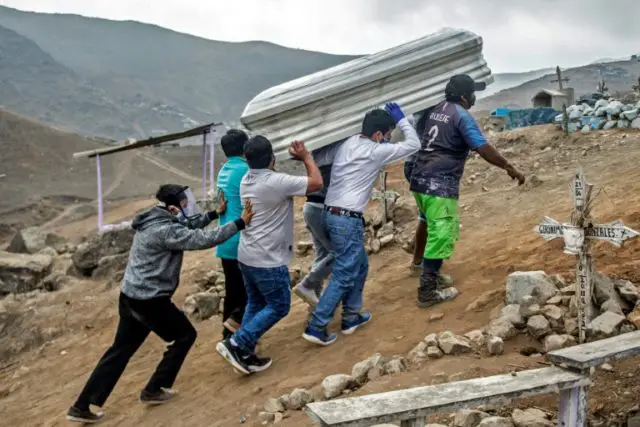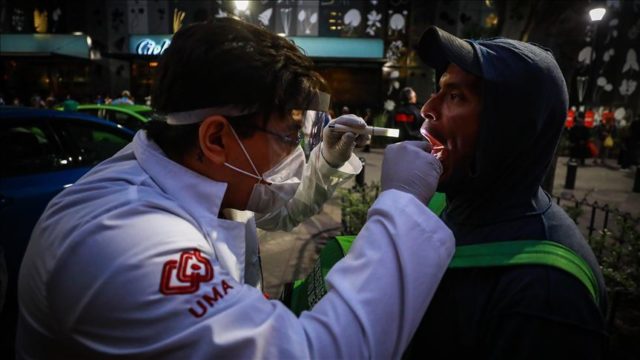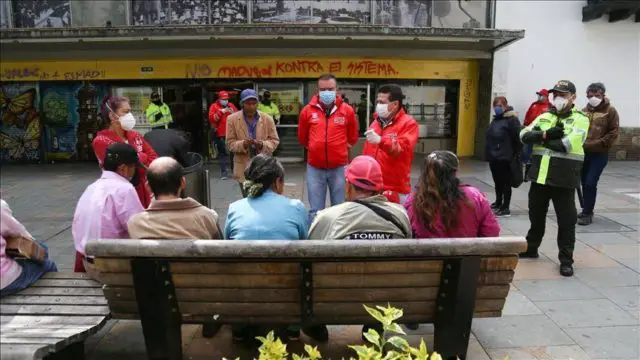
It does not matter in which region or country of the world, every sick person, every death, every recovery counts. But the total numbers of infections and deaths from COVID-19 in Brazil (more than two million cases and 80 thousand deaths), Mexico (more than 350 thousand cases and 40 thousand deaths), Peru (more than 360 thousand cases and 13,500 deaths), Chile (more than 330 thousand cases and 8,600 deaths) and Colombia (more than 210 thousand cases and 7 thousand deaths) alarms us in this region.
However, if they are normalized by the population, these figures are rearranged. Chile tops the lists of infections and deaths per million inhabitants (with more than 17 thousand cases and 451.61 deaths). Although it also leads in the number of laboratory tests (PCR) performed per thousand inhabitants (75.6). And it is second in the proportion of recovered per total infected (92.40%).

It is followed, in infections per million, by Panama (with more than 12 thousand), Peru (almost 11 thousand), Brazil (almost 10 thousand), Bolivia (more than 5 thousand), Dominican Republic, Puerto Rico, Ecuador, Colombia (more than 4,000), Honduras (more than 3,000), Argentina, Mexico, Costa Rica, Guatemala (more than 2,000), El Salvador, Suriname (almost 2,000), Haiti (more than 600), Paraguay (more than 500 ), Nicaragua, Venezuela, Guyana (more than 400), Uruguay (more than 300), Jamaica, Cuba (more than 200) and Belize (more than 100).
In deaths per million, Peru (405.95) and Brazil (376.93) also follow. Then, Mexico (306.24), Ecuador (301.42), Panama (261.20), Bolivia (190.01), Colombia (136.18), Honduras (94.40), Dominican Republic (91.54 ), Guatemala (83.84), Puerto Rico (62.92), El Salvador (54.27), Argentina (52.5), Suriname (35.80), Guyana (24.16), Nicaragua (14, 94), Costa Rica (12.96), Haiti(12.80), Uruguay (9.5), Cuba (7.68), Belize (5.03), Paraguay (4.63), Venezuela (4.08), Jamaica (3.38).
In the matter of recovery of the infected, everything is rearranged again: Cuba leads (94.48%), then Chile and Jamaica (87.53%), Uruguay (84.76%), Nicaragua (72.46%), Peru (68.70%), Brazil (67.62%) Guatemala (66.33 %), Mexico (63.76%), Suriname (62.33%), Paraguay (60.44%), Haiti (57.30%), Panama (54.53%), Venezuela (54.67%) , Guyana (48.08%), Dominican Republic (47.40%), Colombia (46.84%), Argentina (44.47%), Ecuador (42.94%), Bolivia (30.93%), Costa Rica (27.04%), and Honduras (11.72%).
Do more cases equal worse crisis management?
These official figures, processed by international statistical projects such as Johns Hopkins University, Our World in Data, or Worldometers, change several times a day, although the trends they set last a little longer.
The country that has the most cases does not mean that it is the one that is doing the worst,” Dr. Marcos Espinal, director of the Department of Communicable Diseases of the Pan American Health Organization (PAHO), assures.
According to the figures, it would seem, for example, that the development of the Pandemic in Haiti, Nicaragua, or Venezuela can be compared to that of countries such as Costa Rica, Uruguay, Paraguay or Cuba. But all these figures must also be read with the prism of the reliability of the data and, especially, of the magnitude of the testing on which they are based.

Without sufficient evidence “we cannot have a clear picture of how the Pandemic behaves”, and this is something that happens in Haiti, a country without resources, or even in Brazil, Espinal says. Haiti does one test for every thousand inhabitants, for example, while Uruguay does 26, Cuba 20, Paraguay 15, and Costa Rica 13. Brazil, for its part, is doing 23, despite having a spread of the Pandemic comparable to that of Chile (which does more than three times more tests). That, without counting how many people with mild symptoms do not even report their case or are detected by the health systems of the different countries.
In the case of Nicaragua, PAHO recognizes difficulties with the continuity of the reports and the disaggregation of the data. And in Venezuela, the limited reliability of rapid tests, widely used in the country, compared to PCR tests, is an issue. But, in general, most of the countries have responded “very committed” to the recommendations and maintain “very fluid communication” with PAHO, insists Dr. Espinal. And refers to the implementation of non-pharmaceutical measures (use of a mask, hand washing, social distancing). As well as the preparation of ports and airports, hospitals, availability of beds, personal protective equipment, intensive care areas (ICU), decentralization of laboratory tests (tests), research capacity and patient assistance, prevention, and control from (other) infections, etc.
In addition to communicative and educational programs that attend and respect population groups in situations of vulnerability such as the Amazonian Indigenous natives, with their levels of literacy, culture, and language. All these are essential functions of the international sanitary organization, with which the signatory countries committed.
However, PAHO prefers to highlight the strengths of each country: the use of mobile primary care teams in Costa Rica, the massive Chilean testing program; or the advantage of federalism and the Brazilian primary care system, key for diagnosis today and for prevention with a possible vaccine in the future.
Does Chile have many cases because it tests a lot?
“We have very populous cities, excessive, unplanned urbanization in our region. Big cities like Rio, Sao Paulo, Mexico City, Lima, surrounded by belts of poverty, overcrowding,” recalls Espinal.
The SARS-CoV-2 Coronavirus that causes the COVID-19 disease was introduced in several countries through the wealthiest social classes, but “it was passed on to the low-income neighborhoods, where there is less possibility of maintaining social distancing,” explains the expert from PAHO.
Just what happened in Chile? Specifically in the capital, which concentrates 40 percent of the country’s population and is the pacemaker of the Pandemic in that nation? After five months of experience with the Virus, the expert recognizes that, although the country increased its diagnostic capacity by PCR from the beginning, it did not control the spread of the disease in the first months. So it is the high community circulation of the Virus, the high rate of positivity that the PCR tests have yielded, and not only the country’s capacity, that has determined the sustained extension of the testing.
“Chile began the measures to restrict movement and issue quarantines, partially and late,” says a Chilean epidemiologist. Remembering the initial strategy of “dynamic quarantines” implemented by the authorities in Santiago, despite the disapproval of the scientific community. Municipalities or fragments of municipalities entered or left the quarantine, according to the evolution of the situation in short periods of less than two weeks, “which does not make any epidemiological sense, for the resources we have, we have not done so well,” laments and points out the example of Argentina, “which has controlled quite well, with early economic measures and social aid,” says the expert.
Peru: excessive urbanization and high rate of the informal economy
Countries like Peru, which took early containment and mitigation measures, for example, have also been affected by their high rate of the informal economy, large groups of vulnerable populations, and high rates of other diseases such as tuberculosis and malnutrition.
In our region, “the most inequitable in the world,” COVID-19 is not the only health challenge, Espinal insists: “We have tuberculosis, malaria, and dengue. We are going to have influenza coming into the southern hemisphere.”
In other countries, the premature reactivation of economic activity, understandable by the economic and social challenge that accompanies this public health crisis, has also had an impact on the control of the Pandemic.
In general, among those most fatally affected by the Virus, as elsewhere, in addition to the elderly, are the poorest and most vulnerable populations: Afro-descendants and indigenous people, for example.
In Chile, mobility in vulnerable areas continued considerably more than in the richest municipalities, due to the need to go out to work and buy food. “Mortality rates in popular neighborhoods like La Quintana have been up to eight times higher than those in affluent areas like Vitacura, Providencia or Las Condes”, the health expert affirms.
Lessons to be taken into consideration

“This is a virus that affects 80 percent of cases mildly or moderately. So if we can avoid deaths, we are doing our job,” emphasizes Dr. Espinal. “Those recovered continue to increase in our countries because every day we learn a little more about the disease,” he adds.
In this sense, he insists on the need to improve information systems and incorporate diagnostic figures without virological confirmation (cases deduced by symptoms, without PCR test). Something that Chile is doing, but does not include, like most countries, in its reports to PAHO.
Soon, hopefully, next year, PAHO bets on the WHO COVAX program to guarantee rapid, fair, and equitable access to vaccines against COVID-19 in the region, as in the rest of the world; as well as its Revolving Fund for the purchase of vaccines.
But, at the national level, this Pandemic leaves a clear lesson for politicians in our societies, Espinal concludes: “The need to increase public investment in health in all our countries,” gradually and steadily. Remembering that most countries of the region do not reach the minimum recommended by PAHO: “six percent” of GDP.

